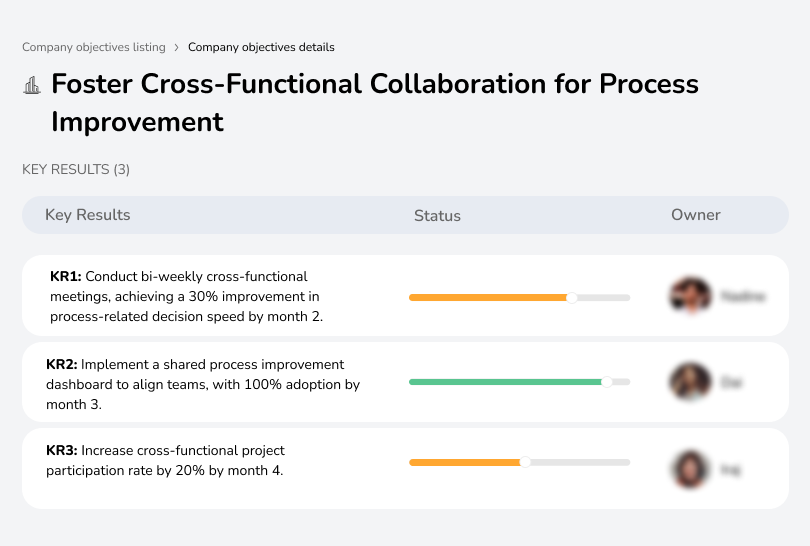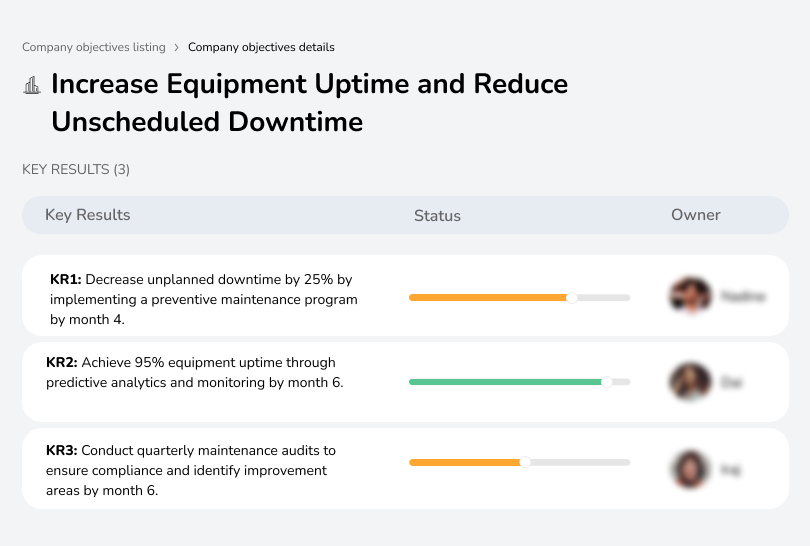Free OKR Templates
Download templatesThe VP of Operations in process manufacturing oversees and optimizes all aspects of production, ensuring that operations run smoothly, efficiently, and safely. They manage manufacturing processes, resource allocation, and production schedules to meet customer demands while maintaining quality and cost-effectiveness.
This role requires strategic leadership to improve operational efficiency, implement best practices, and drive continuous improvement across production lines. The VP of Operations collaborates with cross-functional teams to align operations with business goals and ensure compliance with industry regulations.
In process manufacturing, the VP of Operations plays a pivotal role in driving productivity, minimizing waste, and ensuring that products meet the highest quality and safety standards, contributing to the organization’s overall success.
15 OKR Templates for VP of Operations (Process Manufacturing)
1. Challenge: Low throughput affects production volumes and operational efficiency
Objective: Enhance Production Throughput and Efficiency
Owned by: VP of Operations
Due date: 6 months
- KR1: Increase production throughput by 20% by optimizing process flows and reducing downtime by month 4.
- KR2: Implement a continuous improvement program, achieving a 10% reduction in cycle time by month 5.
- KR3: Boost line efficiency to 95% by improving scheduling and reducing bottlenecks by month 6.
2. Challenge: High levels of waste lead to increased costs and resource inefficiencies
Objective: Reduce Waste and Improve Yield
Owned by: VP of Operations
Due date: 5 months
- KR1: Reduce raw material waste by 15% through process optimization by month 3.
- KR2: Improve product yield by 10% by standardizing operational procedures and enhancing quality checks by month 4.
- KR3: Implement waste-reduction training for all operational staff, achieving 100% participation by month 5.
3. Challenge: Unplanned downtime negatively impacts production targets and costs
Objective: Increase Equipment Uptime and Reduce Unscheduled Downtime
Owned by: VP of Operations
Due date: 6 months
- KR1: Decrease unplanned downtime by 25% by implementing a preventive maintenance program by month 4.
- KR2: Achieve 95% equipment uptime through predictive analytics and monitoring by month 6.
- KR3: Conduct quarterly maintenance audits to ensure compliance and identify improvement areas by month 6.
4. Challenge: High energy costs impact operational expenses and environmental footprint
Objective: Improve Energy Efficiency in Production Processes
Owned by: VP of Operations
Due date: 5 months
- KR1: Reduce energy consumption by 15% through optimized equipment usage and efficient scheduling by month 3.
- KR2: Implement energy-efficient technologies, achieving a 10% reduction in carbon footprint by month 5.
- KR3: Conduct monthly energy audits, achieving 100% compliance with energy standards by month 5.

5. Challenge: Non-compliance with safety regulations leads to risks and penalties
Objective: Enhance Process Compliance and Safety Standards
Owned by: VP of Operations
Due date: 4 months
- KR1: Achieve 100% compliance in monthly safety audits across all operational facilities by month 2.
- KR2: Reduce reportable safety incidents by 50% by implementing rigorous safety protocols by month 3.
- KR3: Ensure 100% staff participation in quarterly safety training sessions by month 4.

6. Challenge: Supply chain disruptions impact production timelines and output
Objective: Streamline Supply Chain for Better Production Continuity
Owned by: VP of Operations
Due date: 6 months
- KR1: Achieve 95% on-time material delivery rate by optimizing vendor communication and scheduling by month 4.
- KR2: Establish safety stock levels for critical materials to reduce shortages by 20% by month 5.
- KR3: Increase supplier performance monitoring, achieving a 30% improvement in on-time delivery by month 6.

Innovation and Technology Team (Chemical Manufacturing) Templates: Click here
7. Challenge: High defect rates reduce product quality and increase rework costs
Objective: Boost Quality Control and Minimize Defective Output
Owned by: VP of Operations
Due date: 5 months
- KR1: Reduce defect rate by 15% by implementing statistical process control methods by month 3.
- KR2: Achieve 100% quality checks at each production stage by month 4.
- KR3: Conduct monthly quality training, improving staff adherence to quality standards by 20% by month 5.
8. Challenge: Excess inventory ties up capital and increases storage costs
Objective: Optimize Inventory Management to Reduce Excess Stock
Owned by: VP of Operations
Due date: 6 months
- KR1: Decrease average inventory levels by 20% through demand forecasting and inventory optimization by month 4.
- KR2: Implement a JIT (Just-In-Time) inventory system to reduce holding costs by 15% by month 5.
- KR3: Achieve 95% inventory accuracy by implementing a real-time tracking system by month 6.
9. Challenge: Siloed teams slow down decision-making and innovation
Objective: Foster Cross-Functional Collaboration for Process Improvement
Owned by: VP of Operations
Due date: 4 months
- KR1: Conduct bi-weekly cross-functional meetings, achieving a 30% improvement in process-related decision speed by month 2.
- KR2: Implement a shared process improvement dashboard to align teams, with 100% adoption by month 3.
- KR3: Increase cross-functional project participation rate by 20% by month 4.

10. Challenge: Lack of data-driven insights limits operational improvements
Objective: Develop a Data-Driven Decision-Making Culture
Owned by: VP of Operations
Due date: 5 months
- KR1: Train 100% of operations managers on data analytics tools by month 2.
- KR2: Implement a production analytics dashboard, achieving 90% usage by month 4.
- KR3: Increase data-driven project implementation by 30% by month 5.

11. Challenge: High operational costs impact profitability and efficiency
Objective: Reduce Operational Costs Across Production Processes
Owned by: VP of Operations
Due date: 6 months
- KR1: Decrease production cost per unit by 15% through process efficiency improvements by month 3.
- KR2: Identify and eliminate 10 non-value-added activities, achieving 100% implementation by month 5.
- KR3: Implement cost-saving initiatives in material procurement, achieving 12% savings by month 6.

12. Challenge: Inconsistent quality and delivery issues lead to customer dissatisfaction
Objective: Improve Customer Satisfaction by Meeting Quality and Delivery Expectations
Owned by: VP of Operations
Due date: 6 months
- KR1: Achieve a 95% on-time delivery rate for all orders by month 4.
- KR2: Reduce product return rate by 20% through enhanced quality control processes by month 5.
- KR3: Increase customer satisfaction score by 10 points by month 6.







